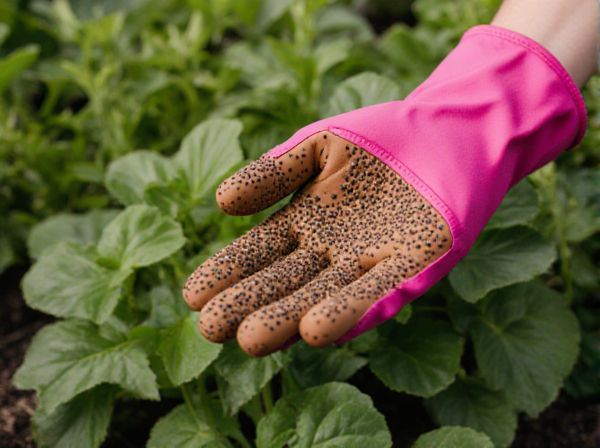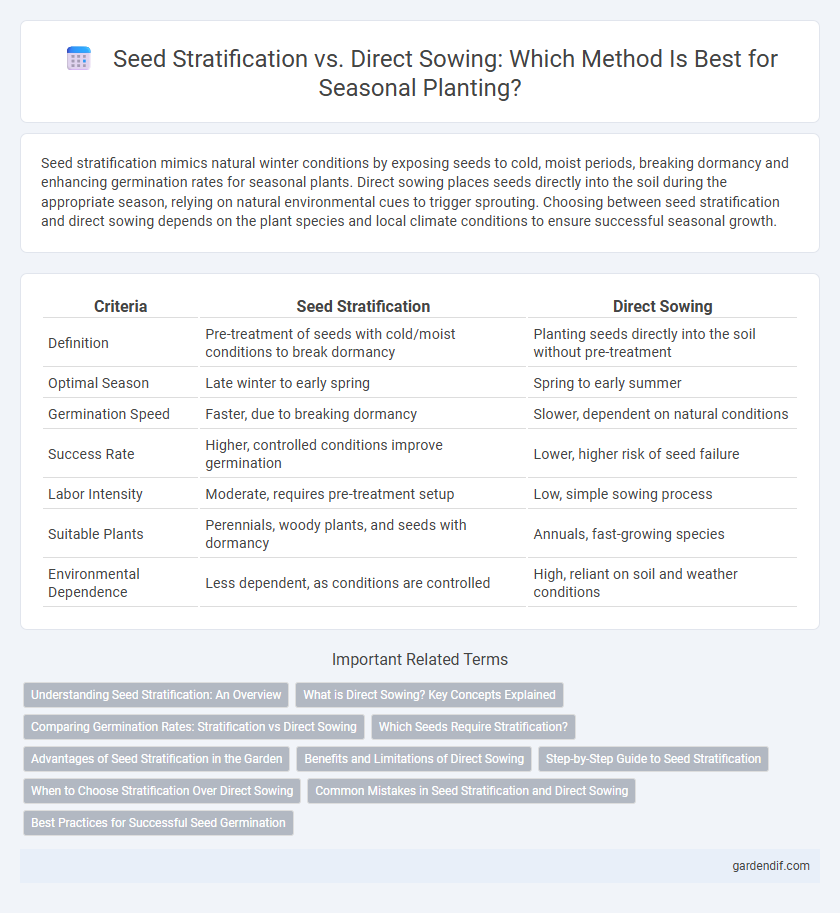
Seed Stratification vs Direct Sowing Illustration
Seed stratification mimics natural winter conditions by exposing seeds to cold, moist periods, breaking dormancy and enhancing germination rates for seasonal plants. Direct sowing places seeds directly into the soil during the appropriate season, relying on natural environmental cues to trigger sprouting. Choosing between seed stratification and direct sowing depends on the plant species and local climate conditions to ensure successful seasonal growth.
Table of Comparison
| Criteria | Seed Stratification | Direct Sowing |
|---|---|---|
| Definition | Pre-treatment of seeds with cold/moist conditions to break dormancy | Planting seeds directly into the soil without pre-treatment |
| Optimal Season | Late winter to early spring | Spring to early summer |
| Germination Speed | Faster, due to breaking dormancy | Slower, dependent on natural conditions |
| Success Rate | Higher, controlled conditions improve germination | Lower, higher risk of seed failure |
| Labor Intensity | Moderate, requires pre-treatment setup | Low, simple sowing process |
| Suitable Plants | Perennials, woody plants, and seeds with dormancy | Annuals, fast-growing species |
| Environmental Dependence | Less dependent, as conditions are controlled | High, reliant on soil and weather conditions |
Understanding Seed Stratification: An Overview
Seed stratification is a crucial process that mimics natural winter conditions to break seed dormancy and enhance germination rates in temperate climate plants such as apple, cherry, and oak trees. This method involves exposing seeds to cold, moist environments for a specific period, typically ranging from 4 to 12 weeks, to trigger physiological changes necessary for sprouting. Compared to direct sowing, stratification increases the likelihood of uniform seedling emergence and stronger root development, optimizing seasonal growth cycles and improving overall plant establishment.
What is Direct Sowing? Key Concepts Explained
Direct sowing involves planting seeds directly into the soil where they will grow, bypassing the need for indoor germination or transplanting. This method is ideal for hardy plants that can withstand environmental conditions from the moment of sowing, ensuring natural root development and reducing transplant shock. Key factors for successful direct sowing include soil temperature, moisture levels, and proper seed depth to optimize germination and seedling growth.
Comparing Germination Rates: Stratification vs Direct Sowing
Seed stratification significantly enhances germination rates by mimicking natural winter conditions, breaking seed dormancy and promoting faster, more uniform sprouting compared to direct sowing. Direct sowing often results in lower germination percentages and prolonged emergence times, particularly in species with hard seed coats or physiological dormancy. Studies show stratified seeds can achieve germination rates up to 85-90%, whereas direct sown seeds frequently display variable rates between 40-60%, emphasizing stratification's impact on seedling establishment success.
Which Seeds Require Stratification?
Seeds from temperate-climate plants such as apple, cherry, and lilac require stratification to break dormancy and ensure successful germination. Cold, moist conditions mimic natural winter cycles, prompting biochemical changes essential for seed viability. In contrast, hardy annuals and tropical plants typically bypass stratification, thriving with direct sowing methods during their optimal growing seasons.
Advantages of Seed Stratification in the Garden
Seed stratification improves germination rates by mimicking natural winter conditions, effectively breaking seed dormancy for species that require cold exposure. This method enhances uniform sprouting, leading to stronger seedlings and more predictable growth patterns in the garden. Stratified seeds are less susceptible to soil-borne diseases compared to direct sowing, reducing early plant mortality.
Benefits and Limitations of Direct Sowing
Direct sowing promotes natural seed germination by exposing seeds to ambient soil conditions, reducing transplant shock and labor costs. It allows for planting larger areas efficiently but faces limitations such as vulnerability to weather fluctuations, pests, and lower germination rates compared to controlled seed stratification. The method suits hardy plants with strong seedlings but may require repeated sowing to ensure successful crop establishment.
Step-by-Step Guide to Seed Stratification
Seed stratification involves mimicking natural winter conditions to break seed dormancy by exposing seeds to cold and moist environments for a specific period, often between 4 to 12 weeks depending on species. Begin by moistening a sterile medium like sand or peat, mixing it with the seeds, then placing the mixture in a sealed plastic bag kept in the refrigerator at 1-5degC (34-41degF). Regularly check for mold or drying, and after the cold treatment, move seeds to optimal germination conditions for direct sowing or propagation.
When to Choose Stratification Over Direct Sowing
Seed stratification is preferred when dealing with species that require a cold dormancy period to break seed dormancy and enhance germination rates, such as many temperate tree and shrub seeds. Direct sowing is suitable for seeds that naturally germinate in the soil without special treatment, typically during the growing season when temperature and moisture conditions are favorable. Choosing stratification over direct sowing ensures improved seedling vigor and higher success rates for cold-climate or late-spring germinating plants.
Common Mistakes in Seed Stratification and Direct Sowing
Common mistakes in seed stratification include improper temperature control, using incorrect moisture levels, and insufficient stratification duration, which can lead to poor germination rates. In direct sowing, frequent errors involve sowing seeds too deep or too shallow, planting at the wrong time of season, and neglecting soil preparation, all of which negatively impact seedling emergence. Accurate adherence to species-specific stratification protocols and optimal sowing conditions significantly enhances seedling success and overall plant establishment.
Best Practices for Successful Seed Germination
Seed stratification mimics natural winter conditions by exposing seeds to cold, moist environments, breaking dormancy and promoting uniform germination, especially for species like apple, cherry, and lilac. Direct sowing is effective for warm-season crops such as beans or corn, requiring proper soil temperature and moisture to ensure seedling emergence without transplant shock. For best results, stratify seeds per species-specific guidelines and sow directly outdoors after last frost, optimizing soil preparation and moisture management.
Seed Stratification vs Direct Sowing Infographic

 gardendif.com
gardendif.com